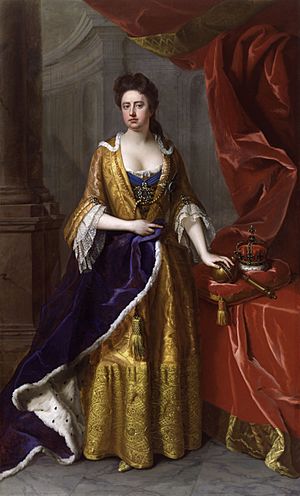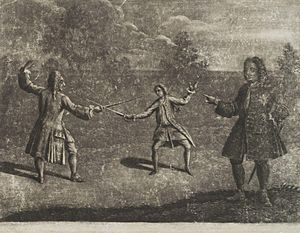Hamilton–Mohun Duel facts for kids
The Hamilton–Mohun Duel was a famous fight that happened on November 15, 1712. It took place in Hyde Park, which was then just outside London. The two main people involved were James Hamilton, 4th Duke of Hamilton, and Charles Mohun, 4th Baron Mohun. Sadly, both men died from their injuries during the duel.
Why Did the Duel Happen?
Even though the duel seemed to be about a family argument over who should inherit some land, it was also deeply connected to politics. Lord Mohun was a well-known member of the Whig political group. The Duke of Hamilton was a Tory, and his party was in charge of the government.
The Duke of Hamilton had just been chosen to be the British Ambassador to Paris. His job was to help make a peace deal called the Treaty of Utrecht. This treaty would end a big war called the War of the Spanish Succession. Lord Mohun's political friend, the Duke of Marlborough, had recently lost his job. He was strongly against the peace plan. This might have made Lord Mohun challenge the Duke to a duel.
Lord Mohun was known for being involved in many duels. He had a reputation for being violent. His own father, the 3rd Baron Mohun, had also died in a duel.
The Duel in Hyde Park
The Duke of Hamilton accepted Lord Mohun's challenge to fight with swords. The Duke chose his relative, Colonel John Hamilton, to be his second. A "second" was a person who helped arrange the duel and stood by the duelist. Lord Mohun chose his friend, an Irish officer named George Macartney, as his second. In those days, the seconds sometimes joined in the fight too.
The group met very early in the morning in Hyde Park. When the duel started, Hamilton and Mohun fought very fiercely. They were described as fighting "like wild beasts." Both Mohun and Hamilton were hurt during this intense exchange. Mohun received a fatal wound to his chest. Hamilton was cut on his arm.
What happened next was debated for a long time. Colonel Hamilton said that after the duel, he went to help the Duke, who had dropped his sword. He claimed that Macartney then stepped forward and delivered a final, deadly blow to the Duke. The Duke died soon after from his wounds.
What Happened After?

The two seconds, Macartney and Colonel Hamilton, were both accused of being involved in the deaths. Colonel Hamilton turned himself in. However, Macartney ran away to a place called Hanover. He only came back to Britain when George I became king.
Based on Colonel Hamilton's story, the Tories in Parliament said the whole duel was a plot by the Whigs. They claimed it was meant to stop the peace agreement with France.
In December 1712, Colonel Hamilton was put on trial. He was found guilty of manslaughter, which is a less serious crime than murder. He received a lighter punishment because the jury believed he didn't know a duel was going to happen when he arrived at the park.
The extreme violence of this duel shocked the public. It led to a stronger push to stop dueling. In April 1713, Queen Anne herself spoke out against the practice. Even though dueling continued to be a way to settle arguments in the 1700s, new rules appeared. For example, people started using pistols more often instead of swords. Also, the seconds stopped joining in the actual fighting.




